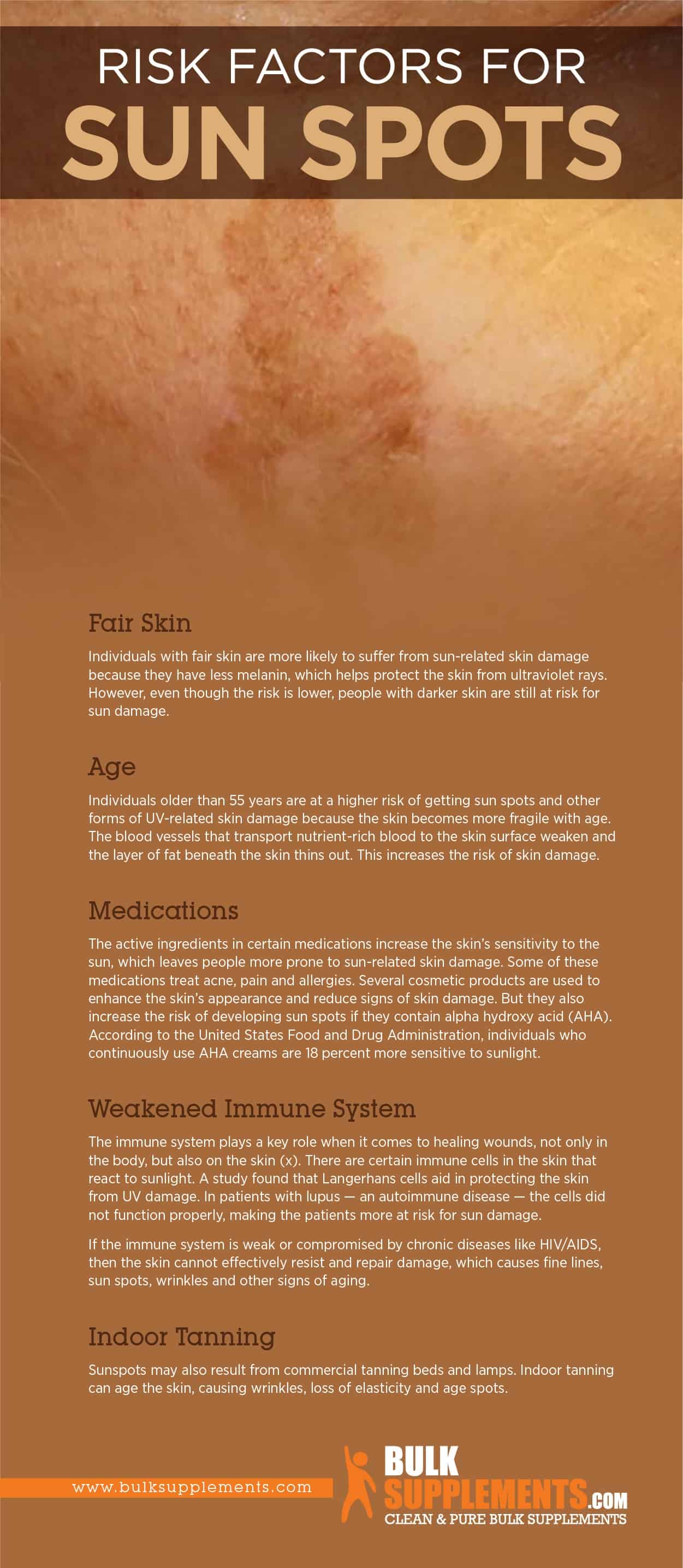Sunspots: Symptoms, Causes & Treatment

Sunspots
What are Sunspots?
Though the sun’s golden warmth on the skin may feel good, it can wreak havoc at times. Sunspots are one of the most common and most visible signs of sun damage. They are also known as age spots, liver spots or solar lentigo. They vary in size and usually appear on the shoulders, hands and on the face. These are the areas that are most exposed to the sun. Sunspots are flat portions of increased pigmentation. They usually appear brown or black. Sunspots are harmless, painless and do not necessarily need medical attention. However, they could indicate a more serious type of skin damage or skin cancer.
Causes of Sunspots
Sunspots result from overactive melanin, a pigment in the skin that gives it its color. Ultraviolet light from the sun causes the body to produce more melanin and prolonged sun exposure results in high melanin concentrations. But instead of spreading evenly, the pigment collects on certain areas of the skin, resulting in sunspots.
Risk Factors for Sunspots
People of all genders, backgrounds, lifestyles and ages are prone to sunspots. However, there are several factors that increase the risk of developing sun-related discoloration.
Fair Skin
Individuals with fair skin are more likely to suffer from sun-related skin damage because they have less melanin, which helps protect the skin from ultraviolet rays. However, even though the risk is lower, people with darker skin are still at risk for sun damage.
Age
Individuals older than 55 years are at a higher risk of getting sun spots and other forms of UV-related skin damage because the skin becomes more fragile with age. The blood vessels that transport nutrient-rich blood to the skin surface weaken and the layer of fat beneath the skin thins out. This increases the risk of skin damage.
Medications
The active ingredients in certain medications increase the skin’s sensitivity to the sun, which leaves people more prone to sun-related skin damage. Some of these medications treat acne, pain and allergies. Several cosmetic products are used to enhance the skin’s appearance and reduce signs of skin damage. But they also increase the risk of developing sun spots if they contain alpha hydroxy acid (AHA). According to the United States Food and Drug Administration, individuals who continuously use AHA creams are 18 percent more sensitive to sunlight.
Weakened Immune System
The immune system plays a key role when it comes to healing wounds, not only in the body, but also on the skin. There are certain immune cells in the skin that react to sunlight. A study found that Langerhans cells aid in protecting the skin from UV damage. In patients with lupus — an autoimmune disease — the cells did not function properly, making the patients more at risk for sun damage.
If the immune system is weak or compromised by chronic diseases like HIV/AIDS, then the skin cannot effectively resist and repair damage, which causes fine lines, sun spots, wrinkles and other signs of aging.
Indoor Tanning
Sunspots may also result from commercial tanning beds and lamps. Indoor tanning can age the skin, causing wrinkles, loss of elasticity and age spots.

Other Types of Skin Spots
Melasma
Melasma is a type of skin spot that causes dark patches, mostly on the face — the upper lip, nose and cheeks. According to the American Academy of Dermatology, they are most common in women, especially those in their 20s.
Like sun spots, melasma becomes more severe with sun exposure. But it is also triggered by hormonal changes. It is very common during pregnancy. This condition is called chloasma and often nicknamed the “mask of pregnancy.” But unlike sunspots, melasma is more common in women with darker skin.
Freckles
Freckles are areas with extra melanin pigment, like sun spots, but they are smaller. They are hereditary, meaning infants can carry the gene at birth, but they appear with exposure to sunlight. Freckles become less noticeable as people age. Though they are not dangerous, they may indicate that the skin is sensitive to UV light and a risk for sun damage.
Diagnosing Sunspots
Physicians can usually diagnose sunspots by simply examining the skin visually, especially if the patient shows other factors like age and frequent sun exposure. But sometimes the physician will perform a biopsy and remove a small piece of the spot to evaluate it for abnormalities and rule out skin cancer.
When to See a Doctor
Sunspots are harmless and usually do not need medical attention. However, people should seek medical care if the spots change in appearance. These changes could be signs of a severe form of skin cancer known as melanoma.
- Dark pigmentation or unusual colors
- Change in size
- Irregular border
- Itching, tenderness, swelling or bleeding
- Change in texture
- Sores that don’t heal
Treatment for Sunspots
Sunspots usually don’t require any treatment. But there are options available if the patient wants to make them less noticeable.
Topical Treatments
Topical creams and lotions can help lighten sun spots gradually over time. However, patients should consult a doctor or a dermatologist to choose a treatment. Skin lightening creams can irritate the skin and even contain mercury, which is damaging to the skin.
Cosmetic Procedures
There are several cosmetic procedures that a dermatologist can perform to remove sun spots. Some of these procedures include:
Laser Treatment
Laser treatments fade spots quicker than topical treatments and have longer results. They have a few side effects. The treatment may cause the spots to darken temporarily and may cause the skin to crust.
Cryotherapy
In this procedure, a doctor applies liquid nitrogen to the sunspots to freeze them and destroy the cells.
Microdermabrasion
This procedure is a non-invasive treatment that smooths away age spots by removing the dead surface layer of the skin. It may cause red or flaky skin for a few days. Microdermabrasion is often combined with a chemical peel for better results.
Chemical Peel
A chemical peel uses a chemical solution to exfoliate the skin and remove dead skin cells.
Any of these procedures can cause scarring and increase sensitivity to sunlight. Sunspots can also return, so it’s important to protect the skin after treatment.
SEE ALSO

Diaper Rash: Characteristics, Causes & Treatment
Preventing Sunspots
People can prevent sun spots by limiting their exposure to UVB and UVA rays. Sunspots can be prevented by:
- Avoiding tanning beds
- Applying sunscreen with at least SPF 30 every two hours
- Choosing lip balm with SPF 30
- Avoiding the sun during the hottest hours of the day, from 10 a.m. to 2 p.m.
- Covering the skin with hats, sunglasses, long sleeves and long pants
Supplements for Skin Health
Vitamin C
Vitamin C is an important antioxidant. It offers protection against UVA and UVB rays and can reduce uneven pigmentation in the skin. It is found in fresh fruits and vegetables, but supplements can provide health benefits as well. The suggested serving size is 1,000 mg per day.
Vitamin A
Frequently used in cosmetics, vitamin A helps with photoprotection. This means that it protects the skin against sun damage. Carrots, pumpkins, mangoes, sweet potatoes and papayas are rich in beta-carotene, which the body converts into vitamin A. As a dietary supplement, take 30 mg of vitamin A powder daily.
Vitamin E
Research suggests that vitamin E topicals and dietary supplements can help protect the skin against sun damage and lighten sunspots. Foods rich in vitamin E include avocados, almonds and sunflower seeds. Take vitamin E powder in a daily serving size of 500 mg to 1,000 mg with meals.
Aloe Vera Extract Powder
Aloesin is an active compound in aloe vera, which may effectively lighten hyperpigmentation, including sunspots. Take 1,000 mg of aloe vera extract powder once daily with water as a dietary supplement.
Green Tea Extract
With antioxidant properties, green tea extract benefits overall health and has anti-inflammatory properties and can help repair pigmentation, according to a review published in the Journal of Cutaneous and Aesthetic Surgery.
Apple Cider Vinegar
According to a 2009 review published in the International Journal of Molecular Sciences, the acetic acid found in apple cider vinegar can help lighten sunspots.
Sandalwood
Used in skincare and aromatherapy, sandalwood can help moisturize, heal and brighten the skin.
The Bottom Line
Sunspots are a common sign of skin damage that results from exposure to the sun’s ultraviolet rays. They are small, dark-colored spots that appear on the areas of the skin most exposed to the sun, such as the face, hands, arms, lips and shoulders. When the skin is exposed to sunlight, the body produces more melanin to protect against UV rays. Sunspots form when melanin concentrates in certain areas instead of distributing across the skin.
Sunspots usually do not require any treatment. However, some treatment procedures can help to make the spots less noticeable. If sunspots change shape, size, color or texture, they could be a sign of more serious skin damage or skin cancer. The best way to prevent sunspots is to protect the skin from sun damage with SPF and proper coverage. Supplements can also boost skin health.



